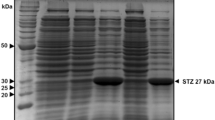Abstract
Axenic transformed shoot cultures of Pimpinella anisum (anise) were established following inoculation of plant stems with the nopaline strain T37 of Agrobacterium tumefaciens. The stable incorporation of T-DNA in the transformed tissues was demonstrated by polymerase chain reaction. Total essential oil accumulated by transformed shoot cultures grown under continuous light was found to be 18% lower (per unit fresh weight of tissue) than that produced by untransformed shoot cultures incubated under similar conditions, but more than 89% lower than the yield of oil from the intact plant. The relative amounts of the principal components of the essential oil of the transformed shoot cultures, namely geraniol, β-bisabolene, trans-pseudoisoeugenol-2-methylbutyrate and transanethole, were similar to those present in the parent plant, but significantly different from those of the untransformed shoot cultures.
Similar content being viewed by others
Abbreviations
- T-DNA:
-
transfer-DNA
- MS:
-
Murashige and Skoog medium
- 2,4-D:
-
2,4-dichlorophenoxyacetic acid
- TY:
-
tryptone and yeast extract medium
- tD :
-
doubling time
- GC-MS:
-
gas chromatography coupled with mass spectrometry
- FID:
-
flame ionisation detector
- PCR:
-
polymerase chain reaction
- TE:
-
Tris-HCl, EDTA buffer
- TBE:
-
Tris, borate, EDTA buffer
References
Brown JT, Hegarty PK & Charlwood BV (1987) The toxicity of monoterpenes to plant cell cultures. Plant Sci. 48: 195–201
Charlwood BV (1993a) Recent advances in the production of aroma compounds in plant culture systems. In: van Beek TA & Breteler H (Eds) Phytochemistry and Agriculture (pp 322–345). Oxford Science Publications, Oxford, England
Charlwood BV (1993b) Towards the enhancement of accumulation of monoterpenoids in vitro. Acta Hort. 330: 255–262
Charlwood BV, Brown JT, Moustou C & Charlwood KA (1988) Pelargoniums: flavours, fragrances and the new technology. Plants Today 1: 42–46
Charlwood BV, Charlwood KA & Molina-Torres J (1990) Properties of plant cell cultures: organized cultures. In: Charlwood BV & Rhodes MJC (Eds) Secondary Products from Plant Tissue Culture (pp 167–200), Oxford Science Publications, Oxford, England
Dellaporta SL (1983) A plant DNA minipreparation. Plant. Mol. Biol. Rep. 1(4): 19–21
Embong MB, Hadziyev D & Molnar S (1977) Essential oil species grown in Alberta. Anise oil (Pimpinella anisum). Can. J. Plant Sci. 57: 681–688
Hamill JD, Rounsley S, Spencer A, Todd G & Rhodes MJC (1991) The use of polymerase chain reaction in plant transformation studies. Plant Cell Rep. 10: 221–224
Mathias RJ & Mukasa C (1987) The effect of cefotaxime on the growth and regeneration of callus from four varieties of barley (Hordeum vulgare L.) Plant Cell Rep. 6: 454–457
Mettler IJ (1987) A simple and rapid method for minipreparation of DNA from tissue cultured plant cells. Plant Mol. Biol. Rep. 5(3): 346–349
Mulder-Krieger T, Verpoorte R, Svendsen AB & Scheffer JJC (1988) Production of essential oils and flavours in plant cell and tissue cultures. A review. Plant Cell Tiss. Org. Cult. 13: 85–154
Murashige T & Skoog F (1962) A revised medium for rapid growth and bioassays with tobacco tissue culture. Physiol. Plant. 15: 473–497
Ooms G, Hooykaas PJ, Moolenaar G & Schilperoort RA (1981) Crown gall plant tumors of abnormal morphology, induced by Agrobacterium tumefaciens carrying mutated octopine Ti plasmids: Analysis of T-DNA functions. Gene 14: 33–50
Reichling J, Becker H, Martin R & Burkhardt G (1985) Comparative studies on the production and accumulation of essential oil in the whole plant and in the cell culture of Pimpinella anisum L. Z. Naturforsch. 40c: 465–468
Reichling J, Martin R & Thron U (1988) Production and accumulation of phenylpropanoids in tissue and organ cultures of Pimpinella anisum L. Z. Naturforsch. 43c: 42–46
Rhodes MJC, Spencer A & Hamill JD (1991) Plant cell culture in the production of flavour compounds. Biochem. Soc. Trans. 19: 702–706
Rhodes MJC, Spencer A, Hamill JD & Robins RJ (1992) Flavour improvement through plant cell culture. In: Patterson RLS, Charlwood BV, MacLeod G & Williams AA (Eds) Bioformation of Flavours (pp 42–64), Royal Society of Chemistry, Cambridge, England.
Spencer A, Hamill JD & Rhodes MJC (1990) Production of terpenes by differentiated shoot cultures of Mentha citrata transformed with Agrobacterium tumefaciens T37. Plant Cell Rep. 8: 601–604
Author information
Authors and Affiliations
Rights and permissions
About this article
Cite this article
Salem, K.M.S.A., Charlwood, B.V. Accumulation of essential oils by Agrobacterium tumefaciens-transformed shoot cultures of Pimpinella anisum . Plant Cell Tiss Organ Cult 40, 209–215 (1995). https://doi.org/10.1007/BF00048125
Received:
Accepted:
Issue Date:
DOI: https://doi.org/10.1007/BF00048125




